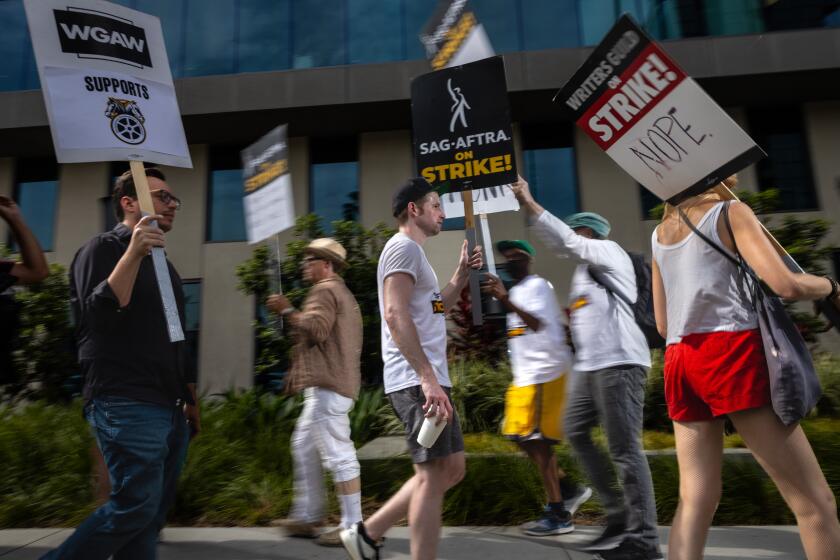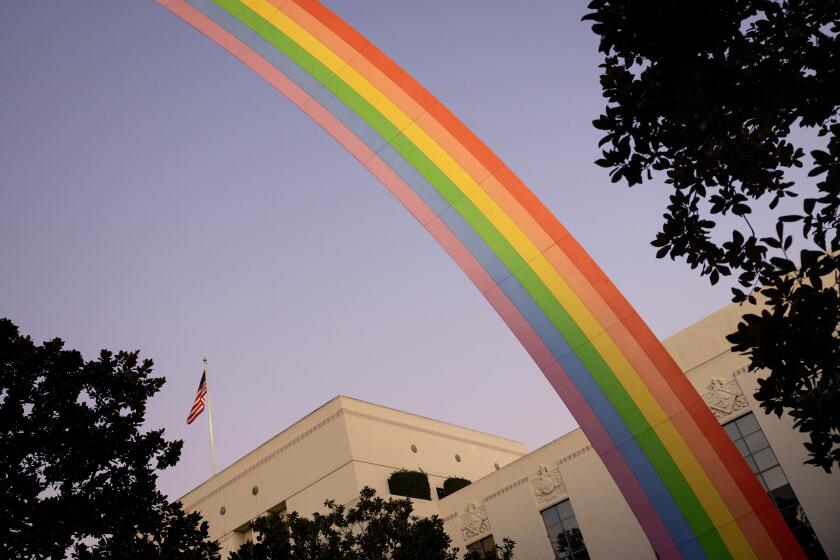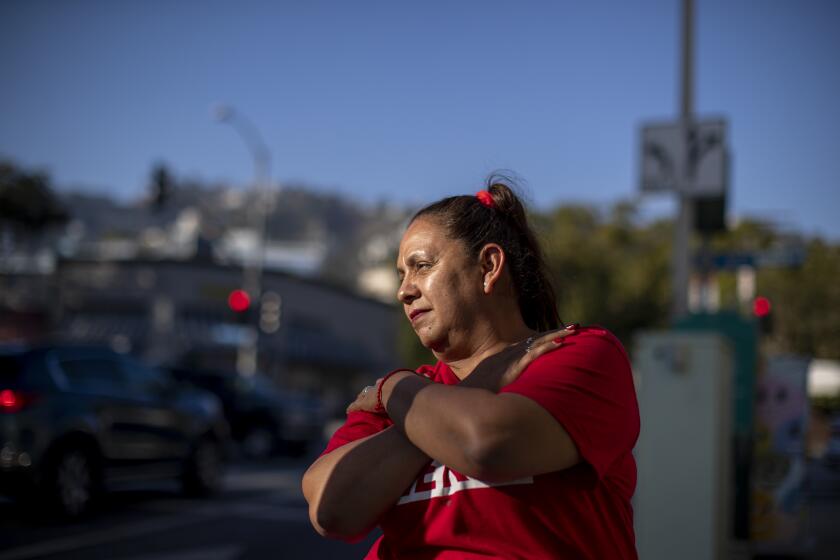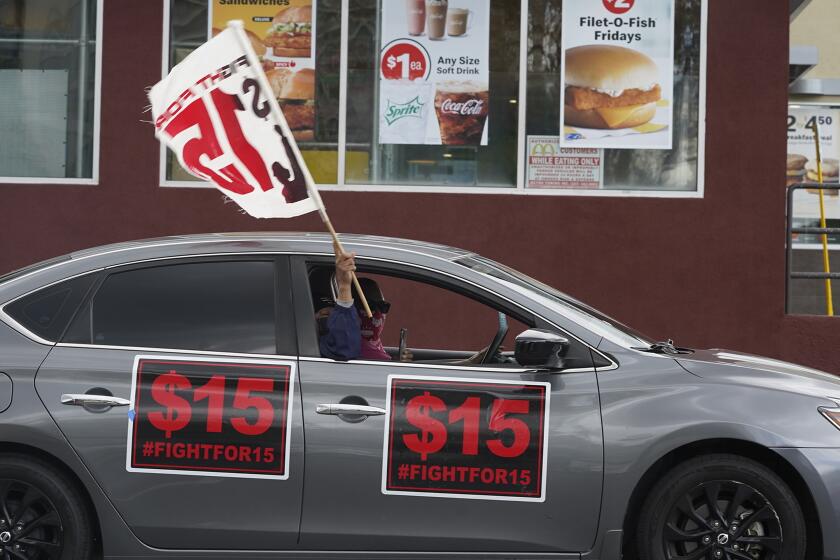It’s been the year of the worker. West Hollywood employers are so over it

- Share via
Across the country, many American workers have enjoyed pay hikes unlike anything seen in decades. And for many American businesses, this also has been a good year for profits, with some corporations notching record or near-record gains.
But don’t try to sing that song of good times in West Hollywood: Business owners there say that paying workers more is killing them, and that goes for some of the low-wage workers who many liberal policymakers worry about.
In an area known for its nightlife, hip restaurants, trendy shops and boutique hotels, workers at or near the minimum pay abound. And, thanks in part to the political muscle of the hospitality union for workers in the Los Angeles area and the COVID-era shakeup that gave workers greater leverage, city leaders there have approved the highest minimum wage and some of the most generous paid time off to be found anywhere in the country.
The West Hollywood rules, approved two years ago, stand in contrast to the situation in much of the country, where business leaders have successfully opposed substantial increases in minimum wages. The federal wage floor has been stuck at $7.25 an hour since 2009, and two dozen states currently are at less than $10 an hour or have no minimum wage at all.
In California as a whole, the minimum wage stands at $15.50 an hour, behind only Washington state at $15.74 and the nation’s capital at $16.50.
Los Angeles is sitting at the vanguard of two trends: increasingly expensive housing and an increasing amount of cross-union solidarity.
Many cities have their own minimum rate, and none higher than West Hollywood, where it’s now $19.08 an hour, with paid leave even for part-time staff.
Economists have long argued over what effect minimum wage rules have on jobs. Conservatives have generally maintained that requiring higher minimum pay leads employers to reduce hiring. Liberal economists have denied such a link in all but theory and some rare exceptions.
For restaurateur Craig Susser and other employers like him, that theoretical point of no return has been reached in West Hollywood. Susser, the owner of Craig’s and Craig’s Vegan, said he has reduced the number of servers from 12 to nine, sometimes eight. Other employers have cut workers’ hours. Many have jacked up their prices.
And by the city’s count, a sizable 177 businesses have closed since 2021, although exit interviews suggest a multitude of reasons, including labor costs, but also inflation more broadly and challenges posed by leases, entertainment industry strikes and changes in consumer behavior after the COVID-19 crisis, said Laura Biery, West Hollywood’s economic development director.
Things have gotten so desperate, some employers say, that in a year when picketing workers have become commonplace and autoworkers, screenwriters and health workers have struck for significant gains, in West Hollywood, it’s bosses who’ve been holding up signs and marching in protest.
Hollywood’s twin strikes translated into a lost year of production for much of the industry with productions idle since last spring. SAG-AFTRA’s strike against major media companies stretched 118 days.
“For God’s sake, give us a break,” said Genevieve Morrill, president of the West Hollywood Chamber of Commerce.
Until relatively recently West Hollywood had followed the state’s minimum wage, which has been rising every year since 2017, mostly by a dollar at a time, to its $15.50 level today.
But that all changed at the start of 2022. Since then West Hollywood’s wage hikes have been extraordinary — more than $6 an hour for small businesses and $5 for larger ones in a span of just 2½ years.
Even some liberal economists are cringing a bit. “That’s such a substantial increase,” said Harry Holzer, a Georgetown public policy professor and the Labor Department’s chief economist in the Clinton administration. He added that bigger increases matter more in the long haul.
West Hollywood businesses are having an even harder time swallowing the city’s paid time off rule that was part of the minimum wage ordinance. That requires employers to provide 12 days of compensated leave per year for full-time employees, at least half in vacation or personal time off and the rest in sick leave.
Many low-wage workers in West Hollywood will see a pay increase on Saturday as the city’s minimum jumps to $19.08 an hour.
For the record:
3:53 p.m. Dec. 4, 2023An earlier version of this article said upon separation, all employees in West Hollywood must be paid for unused vacation or personal leave. They must be paid for any unused paid sick time as well.
Part-timers also qualify on a prorated basis. And upon separation, all employees must be paid for any unused paid sick time as well as accrued vacation or personal leave, something neither the state nor any other city is thought to mandate.
Labor proponents have argued that even $19 an hour isn’t enough to live in expensive L.A. and that the rapid jump in West Hollywood’s minimum wage came after years in which its pay rate trailed that of Los Angeles and neighboring cities. Now, “it’s on the cutting edge of this important debate” over living wages, said Danielle Wilson, political coordinator of Unite Here Local 11. The union has been on strike at hotels across Southern California since the summer and had an influential role in pushing through the West Hollywood pay increases.
Wilson said businesses in West Hollywood can afford it. And some certainly can. Many workers were already making $19 or more an hour, thanks to the labor market upheaval and tight worker supply caused by the pandemic.
Nor has it stopped new startups. This year, more businesses have opened in West Hollywood than have closed, records show. Mario Vollera and his partners are gearing up to open Southern California’s second Roosterfish bar in West Hollywood, in the space where reality TV star Lisa Vanderpump had once operated her restaurant lounge. “I’m not that concerned,” he said of West Hollywood’s pay rules.
The city of about 35,000 is part of the L.A. area’s affluent Westside, home to the Sunset Strip, and its area of 1.9 square miles is chock-full of swanky bars, dance clubs and celebrity hideaways. Although a sliver of West Hollywood touches Beverly Hills, the cities are quite different in demographics and wealth. West Hollywood’s residents are more transient and household incomes and housing values aren’t far off from L.A. County’s averages, census data show. Most workers are employed by small service employers.
Many celebrated the increase as a meaningful step for low-wage workers. Others expressed concerns that it would cripple businesses already hurting from the COVID-19 pandemic.
Interestingly, a Starbucks in West Hollywood now has to pay its employees at least $19.08 an hour, but another one down the road on Sunset Boulevard in Beverly Hills could, at least legally, bring on a worker at the state’s minimum of $15.50. (The current minimum wage for the city of L.A. is $16.78, and it’s $16.90 for Santa Monica.)
“Beverly Hills is actually looking pretty competitive and cheaper than West Hollywood,” said the chamber’s Morrill, letting out a chuckle.
She said it’s doubly hard for employers because the city’s socially progressive history and support for labor have made them reluctant to stick their heads out and complain publicly.
“I’m definitely in support of people making more money,” said one longtime restaurant owner who asked that he remain anonymous. “But it’s going to end up hurting the people it’s intended to help.”
This business owner was one of 21 employers who received a temporary exemption from the citywide minimum wage or paid-leave rules, after supplying proof that the rules would lead to a substantial cut in staff or work hours.
As of today, the minimum wage rises to $16.04 an hour in the city of Los Angeles and $15.96 in unincorporated L.A. County.
Other employers and their supporters, about 30 in all, took to the streets on Thanksgiving week and marched to West Hollywood’s city hall. Their demands: a long pause on future minimum wage increases; a new minimum rate for tipped employees, some of whom employers say make much more than a living wage; and a rescission of the paid leave provision for part-time employees.
West Hollywood’s City Council responded by giving employers relief on an annual business tax and parking and outdoor dining fees, totaling about $2.5 million, and said it would conduct a survey of businesses and consider amendments, but it made no time commitments.
Just how West Hollywood became, almost overnight, the minimum wage leader in part reflects a labor revival after decades of stagnant incomes and pandemic-induced anger that manifested itself in the so-called Great Resignation and worker shortages. Low-wage workers have seen the biggest gains.
West Hollywood labor had a powerful ally in Local 11, which maximized the moment by using its broader political leverage to lean on city officials, according to knowledgeable sources. And what initially began as an effort targeting hotels morphed into an expansive ordinance that passed on a late November 2021 night.
Employers say they were blindsided by the new rules. And while experts say that the changes, on the whole, may not make a big difference for employment, they could for businesses on the margins. More than many others, West Hollywood depends on hospitality businesses, which are labor-intensive and tend to come and go. Some say they may move or expand elsewhere. Others may adopt labor-saving strategies, such as more automation, or simply make do with fewer employees.
“People think of it as a free lunch, but you have to pay for it somewhere,” said David Neumark, a UC Irvine economist who has long studied the effects of minimum wage increases.
“The workers who get higher wages and keep their jobs and hours — they’re better off,” he said. “It’s workers who lose their jobs and hours. There’s the trade-off.”
More to Read
Inside the business of entertainment
The Wide Shot brings you news, analysis and insights on everything from streaming wars to production — and what it all means for the future.
You may occasionally receive promotional content from the Los Angeles Times.
















